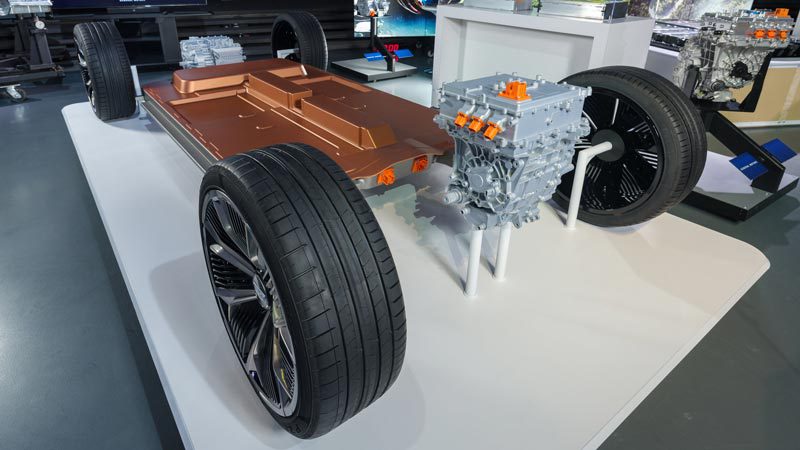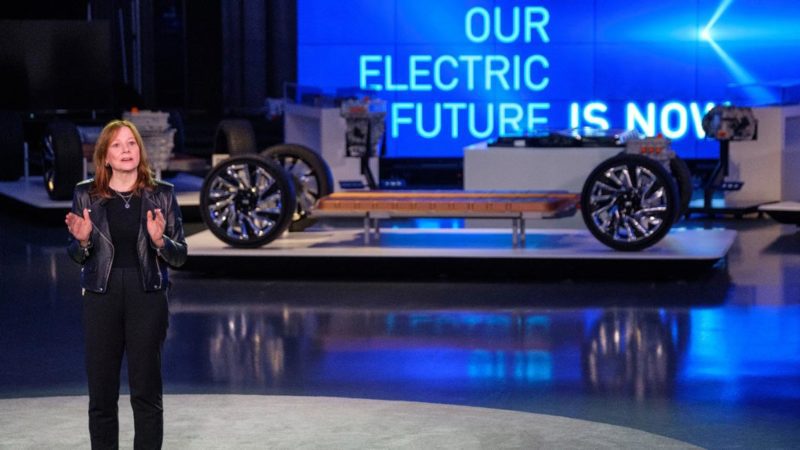General Motors unveiled an ambitious electric vehicle plan on Thursday morning (Australian time) that will see it introduce a wide range of new EVs using a platform with top-of-the-range fast charging capabilities for its largest models.
GM’s new fleet of electric vehicles will be powered with a battery pack design with a capacity of up to 200kWh called the “Ultium” – and it is this, combined with the new platform’s charging options, that make the GM announcement exciting.
Chevrolet, Cadillac, GMC and Buick will all introduce 10 new electric models by 2021, including cars, SUVs, crossover, utility trucks and commercial vehicles.
These will be built on the new modular electric vehicle platform that GM says will either use a 400V or 800V electrical architecture.

The 800V architecture will be used on GM electric trucks (which it is hoped would include utility trucks known as utes in Australia and pickups in the US), enabling 350kW charging capacity that to date has only been seen in the Porsche Taycan (and which is currently limited to 250kW maximum charge rate).
This ultra-fast charging capacity would allow a 200kWh battery – twice the size of the largest Tesla EV batteries – to be recharged from 0-100% in just over half an hour.
Battery capacity options will range from 50kWh up to 200kWh, with GM estimating a top driving range of 400 miles (643km).
While this efficiency is not on par with the likes of Tesla, it is to be expected considering larger packs will be used in large electric trucks (which we suspect would include the all-electric GM Hummer that was given a prominent place in advertising at this year’s Superbowl event) along with the 800V ultra-fast charging architecture.
Nevertheless, compared to educated estimates of the base single-motor Cybertruck’s battery size at 87.5kWh for 250+ miles (400+km) driving range, it does suggest that GM may have some catching up to do in terms of energy efficiency.
But GM’s focus, according to its statement on EV day, is not so much on improving energy efficiency as on bringing down battery costs.
According to GM, which in December announced a $US2.3 billion ($A3.48 billion) partnership with LG Chem to make batteries at a new 30GWh capacity plant, it expects to break the $US100/kWh ($A151/kWh) battery price (although it did not specify when).
The batteries will use a “proprietary low cobalt chemistry and ongoing technological and manufacturing breakthroughs” that will “drive costs even lower”.
GM’s plan to transition to electric is not exactly new (they first announced a massive turnaround from railing against fuel efficiency rules in 2018), but the EV day event has given the most insight into how it plans to achieve it so far.
“This isn’t something that has just happened for the last six months, this is something we have been working on for years,” said GM boss Mary Barra at the event.
“With all of the learnings we’ve had from from the Chevrolet Volt and the Bolt, we are in a very strong position, and now we’re bringing to bear the design capability that General Motors has, the engineering capability on top of the manufacturing capability, along with the scale.”

“Thousands of GM scientists, engineers and designers are working to execute an historic reinvention of the company,” said GM president Mark Reuss in a statement, seeming to confirm the mammoth electrification task with which legacy carmakers are faced.
“They are on the cusp of delivering a profitable EV business that can satisfy millions of customers.”
A new incarnation of the Bolt EV in late 2020 will be followed by a Bolt EUV (an electric SUV) to be launched in the northern hemisphere summer of 2021.
By 2023 the American auto giant plans 23 new electric vehicles in total, including the autonomous Cruise Origin that will be built at GM’s transformed “EV only” Detroit-Hamtramck plant and a luxury electric Cadillac dubbed “Lyriq” that will be revealed in April.
This will be followed by the unveiling in May of the Hummer EV, which was presented in Superbowl advertising by basketball star LeBron James.
Production at the Detroit-Hamtramck plant is slated to start in northern hemisphere fall of 2021, and all new EVs will be built on the new modular platform and use the specially developed “Ultium” batteries that use a “large-format, pouch-style cell format” that GM says can be stacked either vertically or horizontally.

Bridie Schmidt is associate editor for The Driven, sister site of Renew Economy. She has been writing about electric vehicles since 2018, and has a keen interest in the role that zero-emissions transport has to play in sustainability. She has participated in podcasts such as Download This Show with Marc Fennell and Shirtloads of Science with Karl Kruszelnicki and is co-organiser of the Northern Rivers Electric Vehicle Forum. Bridie also owns a Tesla Model Y and has it available for hire on evee.com.au.

